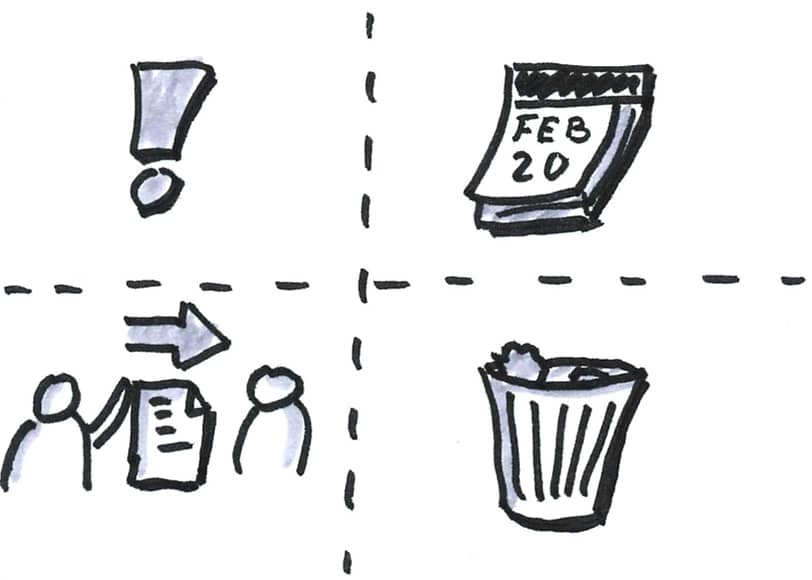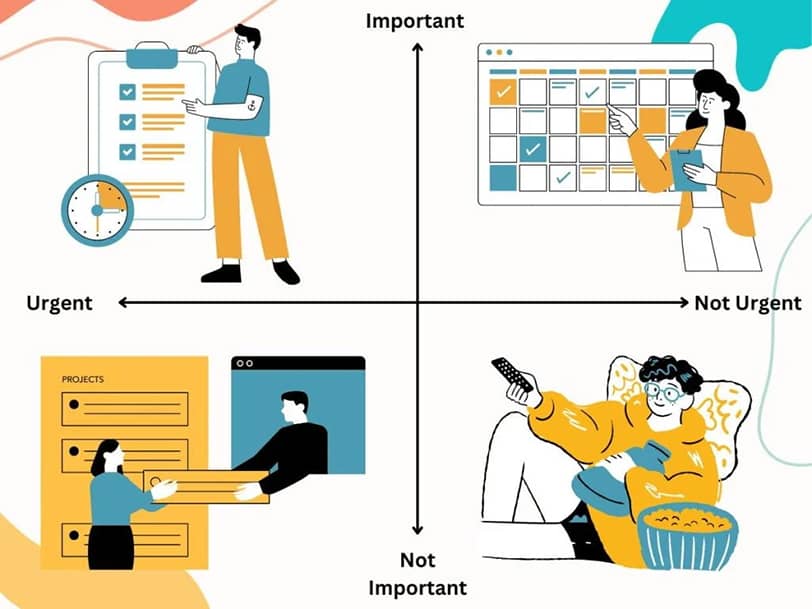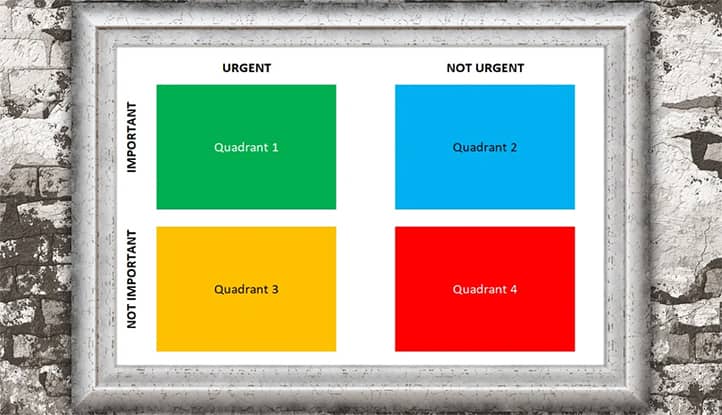In today’s world, where the flow of information and tasks seems endless, many of us struggle with the same problem: we spend too much time on activities that don’t bring real value. Social media, endless notifications, tasks that seem urgent but aren’t truly important—all these distractions pull us away from what genuinely matters.
As a result, we feel overwhelmed yet realize we’re not accomplishing the things that truly count. Why does this happen? Most often, it’s due to a lack of a clear prioritization system. We jump from one task to another without considering which ones truly deserve our attention and which merely create an illusion of busyness.
This is where the Eisenhower Matrix comes in—a simple yet powerful tool for time and task management. This method was developed by Dwight D. Eisenhower, the U.S. president renowned for his incredible productivity.
The essence of the matrix is to categorize all tasks into four groups based on their urgency and importance. This approach not only helps structure your workload but also clarifies what’s truly worth your time and what should be eliminated.
The Eisenhower Matrix helps cut through chaos, focus on what’s essential, and stop wasting energy on meaningless activities. If you want to start making real progress toward your goals, this guide will be an excellent starting point.

What Is the Eisenhower Matrix?
In a world where time is the most valuable resource, mastering the art of prioritization is a crucial skill. One of the most effective tools for achieving this is the Eisenhower Matrix. This method not only helps organize your tasks but also provides clarity on what truly deserves your time and what can be postponed or even removed from your to-do list. The Eisenhower Matrix is more than just a planning tool—it’s a mindset that encourages a conscious approach to task selection and time management.
But what makes this matrix so universal and effective? The secret lies in its simplicity and depth. It doesn’t require complex calculations or special knowledge—just an understanding of its core principles and a willingness to apply them in practice.
The History Behind It
The Eisenhower Matrix is named after Dwight D. Eisenhower, the 34th president of the United States, who was also a distinguished military leader and statesman. Eisenhower was known for his exceptional productivity and ability to manage an overwhelming number of responsibilities. As a general during World War II and later as president, he constantly had to make crucial decisions under time constraints. This experience led him to develop a system for distinguishing truly important tasks from less significant ones.
Eisenhower understood that not all urgent tasks are important, and not all important tasks require immediate attention. His approach involved systematically categorizing tasks based on two key criteria: importance and urgency. This allowed him to manage his time efficiently while avoiding burnout and maintaining a balance between work and personal life. Today, his method is used by millions worldwide—from students to top executives.
The Core Idea
The Eisenhower Matrix is based on the principle of dividing tasks into four categories, or quadrants, based on their importance and urgency. This allows you to quickly determine which tasks require immediate attention, which can be scheduled, which should be delegated, and which should be eliminated altogether.
1. Urgent and Important Tasks
-
- These require immediate action and are high-priority because failing to complete them could have serious consequences.
- Examples: Work deadlines, crises, urgent meetings.
2. Important but Not Urgent Tasks
-
- These don’t require immediate attention but are critical for long-term success.
- Examples: Strategic planning, personal development, relationship-building, health care.
3. Urgent but Not Important Tasks
-
- These seem pressing but don’t actually contribute significantly to your goals. Often, they involve external demands or distractions.
- Examples: Some emails, phone calls, routine tasks that can be delegated.
4. Neither Urgent nor Important Tasks
-
- These activities bring little to no value and simply consume time without meaningful outcomes.
- Examples: Mindless social media scrolling, excessive entertainment, meaningless small talk.
Visual Representation
The Eisenhower Matrix is typically visualized as a square divided into four quadrants, each corresponding to a different category of tasks:
1. Quadrant 1 (Top Left): Urgent and Important Tasks
-
- These require immediate action.
- Example: Completing a project with a strict deadline.
2. Quadrant 2 (Top Right): Important but Not Urgent Tasks
-
- These contribute to long-term success but don’t require urgency.
- Example: Planning a vacation, regular exercise.
3. Quadrant 3 (Bottom Left): Urgent but Not Important Tasks
-
- These feel urgent but have little real value.
- Example: Responding to unimportant emails, handling minor requests from others.
4. Quadrant 4 (Bottom Right): Neither Urgent nor Important Tasks
-
- These add no real value and only waste time.
- Example: Watching excessive entertainment videos, idle chatter.
This visual format makes it easier to assess your tasks at a glance and prioritize effectively. The matrix not only simplifies planning but also helps prevent burnout by clearly distinguishing meaningful work from distractions.

How Does the Eisenhower Matrix Work?
The Eisenhower Matrix is more than just a planning tool—it’s a comprehensive system that helps you consciously manage your time and tasks. Its greatest strength lies in the ability to divide all tasks into four categories based on two key criteria: importance and urgency. This approach not only structures your workload but also helps distinguish between tasks that genuinely deserve your attention and those that merely create the illusion of productivity.
But how exactly does this matrix work? Why is it so effective? The answer is simple: it forces us to think about priorities. We often waste time on tasks that seem urgent but hold little real value. Conversely, we postpone important tasks simply because they don’t require immediate action. The Eisenhower Matrix helps avoid these traps by offering a clear action plan for each type of task.
Quadrant 1: Urgent and Important Tasks
Quadrant 1 includes tasks that require immediate attention and hold high importance. These are tasks that cannot be postponed because failing to complete them may lead to serious consequences.
Examples:
- Meeting a strict project deadline.
- Handling a crisis at work or in personal life.
- Urgent health issues that require immediate intervention.
- Important meetings or negotiations that cannot be rescheduled.
Tasks in this quadrant are non-negotiable—they demand immediate action. However, it’s essential to recognize that constantly operating in this quadrant can lead to stress and burnout. If you find that most of your tasks fall into this category, it’s a sign that you need to plan better and allocate more time to Quadrant 2.
Quadrant 2: Important but Not Urgent Tasks
Quadrant 2 consists of tasks that don’t require immediate attention but are critical for long-term success and well-being.
Examples:
- Setting long-term goals.
- Regular exercise and self-care.
- Self-education and professional development.
- Strengthening relationships with loved ones.
Quadrant 2 is the foundation of productivity and personal growth. Tasks in this category don’t have strict deadlines, but completing them is essential for achieving long-term goals and maintaining balance in life.
By prioritizing Quadrant 2, you can minimize the number of crises in Quadrant 1. Many urgent problems can be prevented in advance—for example, regular planning reduces last-minute rushes, and taking care of your health decreases the risk of sudden medical issues.
Quadrant 3: Urgent but Not Important Tasks
Quadrant 3 includes tasks that appear urgent but don’t significantly contribute to your goals. These tasks often arise from external demands and distractions rather than your own priorities.
Examples:
- Responding to non-essential emails or messages.
- Performing routine tasks that could be delegated.
- Attending meetings that provide little value.
- Handling minor issues that don’t impact your success.
Tasks in Quadrant 3 create an illusion of productivity, but in reality, they distract you from what truly matters. They are often tied to other people’s priorities rather than your own. To reduce these tasks, it’s crucial to learn to say “no” and delegate whenever possible.
For example, if a colleague asks you to do something outside of your responsibilities, politely decline or suggest another person who can handle it. Setting clear boundaries is key to preventing others from shifting their tasks onto you.
Quadrant 4: Neither Urgent Nor Important Tasks
Quadrant 4 consists of tasks that are neither urgent nor important. These activities bring no value and simply consume your time without meaningful outcomes.
Examples:
- Mindless scrolling through social media.
- Watching entertainment videos or binge-watching TV shows.
- Idle gossip or meaningless small talk.
- Playing games or engaging in activities that bring neither joy nor benefit.
Tasks in Quadrant 4 are the biggest time wasters. They not only fail to contribute to your goals but also distract you from meaningful work. If you notice that you’re spending too much time on these activities, it’s a sign that you need to reassess your habits.
Try replacing these distractions with more beneficial activities, such as reading, going for a walk, or meaningful conversations with loved ones. Setting limits on social media use or other distractions can also be helpful.
The Eisenhower Matrix is not just a productivity tool—it’s a mindset shift that changes the way you approach time and tasks. By understanding how each quadrant works, you can effectively manage your time, reduce stress, and achieve long-term success while maintaining a healthy work-life balance.

How to Stop Wasting Time on Useless Activities
To stop wasting time, it’s important not only to recognize unproductive activities but also to effectively manage your tasks. This involves analyzing your current activities, learning to say “no”, delegating tasks, and focusing on long-term goals. Let’s break down each step in detail.
Analyzing Your Current Tasks
The first step to eliminating useless activities is to analyze how you currently spend your time. Take a piece of paper or use a planning app and list all the tasks you engage in throughout the day. Then, evaluate each task based on two criteria: importance and urgency. Tasks that are neither important nor urgent fall into Quadrant 4.
Examples of Quadrant 4 tasks:
- Mindlessly scrolling through social media.
- Watching entertainment videos or TV shows with no value.
- Engaging in meaningless conversations or gossip.
- Activities that bring neither joy nor benefits (e.g., aimlessly browsing the internet).
Once you’ve identified your Quadrant 4 tasks, try to minimize the time spent on them. Set limits on social media usage, replace mindless activities with more productive ones (such as reading or going for a walk), and become more mindful about how you spend your time.
Learning to Say “No”
One of the biggest reasons we waste time is our inability to say no. We often agree to requests from others or participate in activities that don’t align with our priorities simply because we don’t want to seem rude or unfriendly. However, this leads to lost time and energy on unproductive tasks.
How to say “no” effectively:
- Identify your priorities. Before agreeing to something, ask yourself how important it is to you.
- Be polite but firm. You can decline without offending the other person. For example: “Thank you for the offer, but I’m currently focused on more important tasks.”
- Offer an alternative. If you can’t fulfill a request, suggest another person or a different solution.
Examples of situations where saying “no” is necessary:
- A colleague asks for help with a task that isn’t your responsibility.
- A friend invites you to an event that doesn’t interest you.
- You’re asked to participate in a project that doesn’t align with your goals.
Delegating
Tasks in Quadrant 3 (Urgent but Not Important) often distract us from what truly matters. However, many of these tasks can be delegated to others. Delegation helps free up time for more meaningful activities and allows you to focus on your priorities.
How to delegate effectively:
- Identify tasks that can be delegated. These are typically routine activities that don’t require your direct involvement.
- Choose the right person. Ensure the person has the necessary skills and time to complete the task.
- Give clear instructions. Make sure they understand your expectations and deadlines.
- Monitor progress. Check in on the task periodically but avoid micromanaging.
Examples of tasks that can be delegated:
- Responding to non-essential emails or messages.
- Running errands (e.g., purchasing office supplies).
- Attending meetings that don’t require your presence.
Focusing on Quadrant 2
Quadrant 2 consists of tasks that aren’t urgent but are highly important for long-term success and well-being. These tasks help you grow, develop, and achieve your goals. By prioritizing Quadrant 2, you not only improve your life but also reduce the number of urgent crises in Quadrant 1.
How to focus on Quadrant 2 tasks:
- Plan ahead. Schedule time for Quadrant 2 activities in your daily or weekly routine.
- Set long-term goals. Identify what truly matters to you and concentrate on those objectives.
- Avoid procrastination. Don’t postpone important tasks just because they don’t seem urgent.
Examples of Quadrant 2 tasks:
- Planning long-term projects.
- Regular exercise and self-care.
- Self-education and professional development.
- Strengthening relationships with loved ones.
By eliminating useless activities and focusing on what truly matters, you can increase your productivity while also creating more time for personal growth and relaxation.

Practical Steps to Implement the Eisenhower Matrix
The Eisenhower Matrix is not just a theoretical concept but a practical tool that can be easily integrated into your daily life. However, to make it truly effective, you must follow a structured approach.
Many people, after learning about the matrix, try to apply it immediately but face challenges: tasks seem too confusing, priorities are unclear, and results are disappointing. To avoid these problems, it’s essential to follow a step-by-step process, starting with analyzing current tasks and ending with regular reviews of your priorities.
Implementing the Eisenhower Matrix requires discipline and a systematic approach, but the results are worth it. You’ll learn to manage your time effectively, achieve long-term goals, and avoid overload and stress. Let’s break down each step that will help you successfully incorporate this method into your life.
Step 1: Create a List of All Your Current Tasks
The first step in implementing the Eisenhower Matrix is to create a complete list of all the tasks you need to complete. Without a clear understanding of what requires your attention, it’s impossible to prioritize effectively. This step helps “declutter” your mind and gives you a full picture of your responsibilities.
How to create your task list:
- Grab a piece of paper, a notebook, or use a task management app (e.g., Todoist, Notion, Trello).
- Write down all the tasks you need to complete: work-related, personal, short-term, and long-term.
- Don’t try to sort tasks immediately—just list everything that comes to mind.
Example task list:
- Finish a work report.
- Book a doctor’s appointment.
- Call a friend.
- Plan a vacation.
- Respond to emails.
- Exercise.
- Watch a new TV series.
Step 2: Categorize Tasks into the Four Quadrants
Once you’ve created your task list, the next step is to sort each task into one of the four quadrants of the Eisenhower Matrix. To do this, evaluate each task based on two criteria: importance and urgency.
Quadrant classification:
- Quadrant 1 (Important & Urgent): Tasks that require immediate attention and have high importance.
- Quadrant 2 (Important but Not Urgent): Tasks that are crucial for long-term success but don’t require immediate action.
- Quadrant 3 (Urgent but Not Important): Tasks that seem urgent but have little significance.
- Quadrant 4 (Not Urgent & Not Important): Tasks that don’t add value and simply waste time.
Example task distribution:
- Quadrant 1: Finish a work report (deadline today).
- Quadrant 2: Plan a vacation, exercise.
- Quadrant 3: Respond to non-essential emails.
- Quadrant 4: Watch a new TV series.
Step 3: Set Priorities for the Day/Week/Month
After categorizing your tasks, it’s crucial to determine which ones require your attention first. This helps you stay focused and avoid chaos.
How to set priorities:
- Daily: Start with Quadrant 1 tasks (important & urgent), then move on to Quadrant 2 tasks (important but not urgent).
- Weekly: Plan Quadrant 2 tasks to prevent them from becoming Quadrant 1 emergencies.
- Monthly: Focus on long-term goals and projects that contribute to personal growth.
Example priority list:
- Daily: Finish a report, call a friend.
- Weekly: Book a doctor’s appointment, start planning a vacation.
- Monthly: Exercise regularly, complete a self-development course.
Step 4: Regularly Review and Adjust Your Matrix
Life is constantly changing, and so are your tasks. Regularly reviewing the matrix helps you adapt to new circumstances and maintain a balance between urgent and important tasks.
How to review your matrix:
- Daily: At the end of each day, check off completed tasks and adjust the remaining ones.
- Weekly: At the beginning or end of the week, analyze your tasks and refine priorities.
- Monthly: Conduct a deeper review to ensure you’re on track toward your long-term goals.
Example adjustments:
- If too many tasks fall into Quadrant 1, focus more on Quadrant 2 to prevent last-minute crises.
- If you’re spending too much time in Quadrant 4, find ways to reduce distractions and eliminate time-wasting activities.
By following these steps, you can successfully integrate the Eisenhower Matrix into your life. This method will not only help you manage your time efficiently but also teach you to make conscious decisions about your tasks, allowing you to focus on what truly matters.

Example of Using the Eisenhower Matrix
Theory is great, but the true value of any tool can only be assessed in practice. The Eisenhower Matrix is no exception. To understand how it works in real life, let’s look at an example of someone who used it to stop wasting time on useless tasks and significantly improve productivity. This example will show how a simple method can lead to major changes in both life and work.
The story we’ll explore is not a fictional scenario, but a typical situation that many people face. The main character is an ordinary person who, like many of us, struggled with overload, procrastination, and a lack of balance between work and personal life. Thanks to the Eisenhower Matrix, he was able to organize his tasks and make time for what truly matters.
How Did He Use the Matrix to Stop Wasting Time?
Alexei (let’s call him that) worked as a manager in a mid-sized company. His workdays were filled with endless meetings, calls, and emails. He always seemed busy, yet important projects kept getting postponed, and personal goals—such as exercising and self-development—remained out of reach. Alexei felt overwhelmed but also realized that much of his time was spent on tasks that didn’t bring real value.
One day, Alexei learned about the Eisenhower Matrix and decided to apply it in his life. He started by listing all his tasks, which included:
✔ Work-related tasks: Preparing reports, attending meetings, responding to emails.
✔ Personal tasks: Exercising, planning a vacation, reading books.
✔ Daily chores: Grocery shopping, cleaning the house.
Alexei then sorted his tasks into the four Eisenhower Matrix quadrants:
- Quadrant 1 (Important & Urgent): Preparing a report with a tight deadline, urgent client calls.
- Quadrant 2 (Important but Not Urgent): Planning next quarter’s strategy, exercising, reading professional literature.
- Quadrant 3 (Urgent but Not Important): Responding to non-essential emails, attending meetings that could be skipped.
- Quadrant 4 (Not Urgent & Not Important): Mindlessly scrolling social media, watching entertaining videos.
Actions Alexei Took
- He started by completing Quadrant 1 tasks to handle urgent matters.
- Then, he scheduled time for Quadrant 2 tasks, making regular exercise and reading a priority.
- He delegated or eliminated Quadrant 3 tasks if they weren’t important.
- He eliminated Quadrant 4 distractions, setting limits on social media usage.
How His Life and Work Changed
After implementing the Eisenhower Matrix, Alexei became much more efficient at handling work tasks. He stopped wasting time on pointless meetings and unnecessary emails, instead focusing on truly important projects. This allowed him to work faster and improve the quality of his output.
By prioritizing Quadrant 2 tasks, Alexei found time for exercise and self-development. This not only improved his physical and emotional well-being but also gave him new ideas for professional growth.
Previously, Alexei constantly felt overwhelmed, trying to do everything at once. After adopting the matrix, he learned to set priorities and say no to unproductive tasks. This significantly reduced his stress levels and helped him achieve a better work-life balance.
After several months of using the Eisenhower Matrix, Alexei’s life became more structured. He achieved several long-term goals, such as getting a promotion at work and improving his fitness. Additionally, he became more mindful of how he spent his time, which positively impacted his relationships with loved ones.
This example clearly demonstrates how the Eisenhower Matrix can transform a person’s life. Alexei not only stopped wasting time on useless activities but also found time for what truly matters. His story proves that even a simple tool, when used correctly, can lead to profound changes.
If you, like Alexei, feel that you’re wasting time, try implementing the Eisenhower Matrix in your life—the results will pleasantly surprise you!

Mistakes When Using the Eisenhower Matrix
The Eisenhower Matrix is a powerful tool for managing time and tasks, but like any method, it requires the right approach. Many people who start using the matrix face difficulties and make mistakes that reduce its effectiveness. These mistakes can lead to more chaos and stress instead of structure and productivity. To avoid this, it’s important to understand the common pitfalls and how to navigate them.
Overestimating Urgency
One of the most common mistakes is confusing urgent tasks with important ones. Many people tend to react to urgent matters, even when they are not truly significant. This happens because urgent tasks often come with external pressure—calls, emails, requests from colleagues or supervisors. As a result, we start treating these tasks as important, even though they might just be distractions.
Examples of Overestimating Urgency:
- Dropping everything to reply to an email that could wait.
- Attending a meeting that doesn’t require your presence just because it’s scheduled now.
- Spending time on minor issues that could be postponed.
How to Avoid This Mistake:
- Ask yourself: “What will happen if I don’t do this right now?” If the consequences are minimal, the task is likely not important.
- Set priorities: Focus first on Quadrant 1 tasks (important and urgent), then move on to Quadrant 2 tasks (important but not urgent).
- Learn to say no: If a task is urgent but not important, consider delegating or postponing it.
Ignoring a Quadrant 2
Quadrant 2 includes tasks that are important for long-term success but don’t require immediate action. Many people neglect this quadrant because they are too focused on urgent tasks. As a result, they constantly operate in “firefighting mode,” leading to stress and burnout.
Examples of Ignoring Quadrant 2:
- Postponing vacation planning because “there’s no time right now.”
- Skipping workouts to finish an urgent project.
- Never making time for self-education, even though it’s essential for career growth.
How to Avoid This Mistake:
- Schedule Quadrant 2 tasks: Treat them like important meetings—add them to your calendar.
- Build habits: Set aside 30 minutes a day for reading or 1 hour for exercise.
- Focus on long-term goals: Regularly remind yourself that Quadrant 2 tasks are investments in your future.
Reluctance to Delegate
Many people resist delegating tasks, believing they can do everything better themselves. This often stems from perfectionism, lack of trust, or fear of losing control. However, refusing to delegate leads to overload and lower efficiency because you waste time on tasks that someone else could handle.
Examples of Reluctance to Delegate:
- Answering every email yourself, even though an assistant could handle some of them.
- Doing routine tasks that don’t require your direct involvement.
- Not trusting colleagues with important projects, preferring to do everything alone.
How to Avoid This Mistake:
- Identify tasks to delegate: These are usually Quadrant 3 tasks (urgent but not important).
- Find the right people: Make sure they have the necessary skills and time to complete the task.
- Trust but verify: Give people a chance to prove themselves, but also monitor the process.
Mistakes when using the Eisenhower Matrix can reduce its effectiveness, but being aware of them helps you avoid these traps. The key is to remember that the matrix is not just a planning tool—it’s a way to change how you think about time and tasks.

Tips for Maximum Efficiency
To get the most out of this method, it’s important not only to understand its principles but also to apply additional strategies that will help you work more productively while maintaining balance in life. Even the best tool won’t be useful if it’s used incorrectly or inconsistently.
For the Eisenhower Matrix to become your reliable assistant, it’s crucial to integrate it into your daily routine. This includes using modern planning tools, regularly reviewing tasks, and taking care of your physical and emotional well-being. Let’s break down how to do this effectively.
Use Digital Tools
While the Eisenhower Matrix can be managed on paper, using digital tools makes the process more convenient and efficient. Apps and software not only help structure tasks but also provide reminders, sync data across devices, and analyze productivity.
Examples of Useful Tools:
- Todoist – Allows you to create tasks and organize them into categories (quadrants).
- Trello – Great for visually representing the matrix using boards and cards.
- Notion – A versatile tool for creating custom matrix templates.
- Apps like “Eisenhower Matrix” or “Priority Matrix” are specifically designed for this method.
How to Use These Tools:
- Create four sections (quadrants) in your chosen app.
- Regularly add tasks and sort them into the appropriate quadrants.
- Use reminders and deadlines to stay on track with important tasks.
Maintain Balance
The Eisenhower Matrix helps manage tasks, but it shouldn’t become a tool for constant productivity pressure. It’s essential to remember that life is not just about work and goals, but also about rest, relationships, hobbies, and self-care. Without balance, you risk burnout and losing motivation.
How to Maintain Balance:
- Schedule time for rest and hobbies as if they were important tasks.
- Don’t neglect your loved ones—spending time with them matters too.
- Exercise, sleep, and healthy eating should be priorities on your task list.
Example of Balance:
- If you’re working on a major project (Quadrant 1), take breaks to recharge.
- Include Quadrant 2 tasks like exercise or vacation planning in your schedule.
- Don’t be afraid to indulge in Quadrant 4 activities (like watching a movie) if they help you relax.
By following these tips, you’ll be able to use the Eisenhower Matrix with maximum efficiency.

Conclusion
The Eisenhower Matrix is more than just a planning tool—it’s a key to effective time and task management. Its power lies in its simplicity and versatility: it not only helps structure tasks but also encourages a mindful approach to setting priorities.
By categorizing tasks into four groups—important & urgent, important but not urgent, urgent but not important, and neither urgent nor important—you gain clarity on where to focus your time and what to eliminate. This method not only helps with current tasks but also prevents crises by prioritizing long-term goals and personal growth.
Start using the Eisenhower Matrix today. All you need is a task list and a few minutes to sort your tasks into quadrants. Don’t postpone it—the sooner you start, the sooner you’ll see results.
You’ll notice how chaos disappears, replaced by clarity and order. You’ll stop wasting time on unimportant tasks and start focusing on what truly matters. This won’t just boost your productivity, but also free up time for rest, hobbies, and meaningful connections.
The Eisenhower Matrix isn’t just a planning method—it’s a philosophy that teaches us to approach each day with intention and make choices that truly matter. Try it, and you’ll see how this simple yet powerful tool can transform your life for the better.




